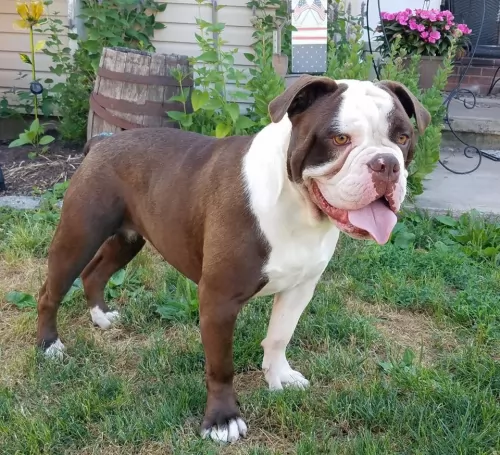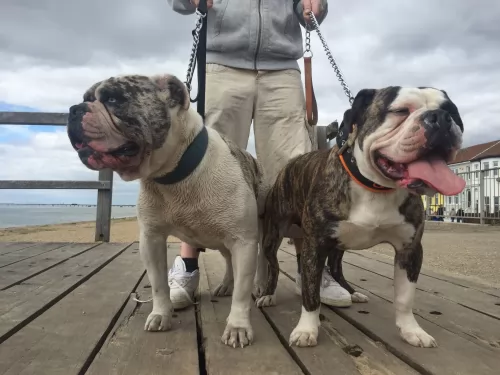 Petzlover
PetzloverAlapaha Blue Blood Bulldog is originated from United States but Vikhan Sheepdog is originated from Pakistan. Alapaha Blue Blood Bulldog may grow 7 cm / 2 inches shorter than Vikhan Sheepdog. Both Alapaha Blue Blood Bulldog and Vikhan Sheepdog are of same weight. Alapaha Blue Blood Bulldog may live 7 years more than Vikhan Sheepdog. Both Alapaha Blue Blood Bulldog and Vikhan Sheepdog has almost same litter size. Alapaha Blue Blood Bulldog requires Moderate Maintenance. But Vikhan Sheepdog requires High Maintenance
 Alapaha has a very interesting history. Their origin dates from one family that lived near Alapaha river in Georgia, in the USA 200 years ago. The family rescued dying breed of Plantation Bulldog. They actually had this breed for 80 years and every dog was named Otto. This breed was not just saved, but the family created a perfect guard dog. Alapaha Blue Blood Bulldog started to expand and by 1980s they spread through the country.
Alapaha has a very interesting history. Their origin dates from one family that lived near Alapaha river in Georgia, in the USA 200 years ago. The family rescued dying breed of Plantation Bulldog. They actually had this breed for 80 years and every dog was named Otto. This breed was not just saved, but the family created a perfect guard dog. Alapaha Blue Blood Bulldog started to expand and by 1980s they spread through the country.
The Vikhan Dog is a rare breed that very little is known about. It is not sanctioned by any breed club or kennel club. The breed originally came from Pakistan in the North-west Frontier Province near the Indian border, in the Chitral region and the state of Himacchal Pradesh. For the most part Pakistan is credited with the development of the breed. They originally guarded livestock and hunting leopard. He is fast and fierce. The breed is bonded to the livestock when they are very young and instinctually guard them for the rest of their life. They do not herd them, they blend into the flock and watch for outsiders.
They confront strangers and predators with aggressive displays and vocal intimidation. If this does not work, it will attack and drive them off. They are even known for luring coyotes into a trap with food so that they can hunt them.
 Alapaha Blue Blood Bulldog height is approximately 61 cm, while their weight variates from 34-47kg. Have in mind that females are slightly smaller than males.
Alapaha Blue Blood Bulldog height is approximately 61 cm, while their weight variates from 34-47kg. Have in mind that females are slightly smaller than males.
A lifespan of Alapaha Blue Blood Bulldog is approximately 11-13 years, but it depends from dog to dog, and with proper care, they can live much longer.
Litter Size of this breed depends but average is 4-8 puppies.
Other Names for Alapaha Blue Blood Bulldogs are Alapaha, Otto, Otto Bulldog.
The Vikhan Sheepdog is a large working breed that is lean, muscular and aggressive. He is immensely intelligent and fearless. He has a thick coat in solid brown, red, fawn or black. There are also multi-colored and spotted versions as well. They are related to the other regional Molossers and are sometimes called the giant Rough Collie. They are faster than they are strong. All Molossers are solid, large and share the same ancestor.
They typically have short, muscular necks and broad but short muzzles. They have heavy bones, wrinkles and pendant ears. With well-muscled legs and wide chests, the Molossers include the mastiffs and bully breeds and all other breeds that come from those groups. Molossers are either flock guardians or home guardians. The Vikhan Sheepdog is a flock guardian
 Alapaha breed is not just beautiful and unique breed, but they are also great family dogs. They are very loyal, but also very protective and sometimes possessive. Alapaha will require a lot of attention. It is very important to train your dog properly from the early age. A steady and firm hand is important so if you are first time owner, consider having this breed twice. You should not punish your dog, or implement any types of old-fashioned way of training. They do not respond well to that. Overall, they are very smart and quick learners. Alapaha needs to be socialized with other animals from the early age. They can be aggressive towards dogs that they don’t know. At first, you can train them around the house with family and friends, and after the puppy receives all the vaccines, you can start with socialization with other dogs. If you are first time owner and you want this beautiful breed, you should advise with more experienced breed owner. They simply have more experience than you and they know and understand the puppies, so you will receive more accurate advice. Have in mind that every dog has its own personality. Overall, if you train your dog properly you will have a happy and healthy dog that will be amazing with other animals and especially family members.
Alapaha breed is not just beautiful and unique breed, but they are also great family dogs. They are very loyal, but also very protective and sometimes possessive. Alapaha will require a lot of attention. It is very important to train your dog properly from the early age. A steady and firm hand is important so if you are first time owner, consider having this breed twice. You should not punish your dog, or implement any types of old-fashioned way of training. They do not respond well to that. Overall, they are very smart and quick learners. Alapaha needs to be socialized with other animals from the early age. They can be aggressive towards dogs that they don’t know. At first, you can train them around the house with family and friends, and after the puppy receives all the vaccines, you can start with socialization with other dogs. If you are first time owner and you want this beautiful breed, you should advise with more experienced breed owner. They simply have more experience than you and they know and understand the puppies, so you will receive more accurate advice. Have in mind that every dog has its own personality. Overall, if you train your dog properly you will have a happy and healthy dog that will be amazing with other animals and especially family members.
 Almost every breed has health issues. That doesn’t mean that your dog will have the same health problems that are typical of the breed. If you choose puppy carefully, from the right breed owners, and if you take them to the regular vet checks with proper diet, most likely that you won’t be having any problems. Alapaha’s usual health problems are hip dysplasia, congenital deafness, entropion- this is an eye related problem, and sometimes they can have skin problems too. Again have in mind that this breed is very healthy and they do not have as many problems as regular bulldogs. The best way to protect yourself from getting a sick dog, you can require tests from the breed owners. If they are reluctant to do that, or they are assuring you that they have healthy dogs, have in mind that something is probably wrong. It is the best to choose a puppy with someone who has more experience with this breed.
Almost every breed has health issues. That doesn’t mean that your dog will have the same health problems that are typical of the breed. If you choose puppy carefully, from the right breed owners, and if you take them to the regular vet checks with proper diet, most likely that you won’t be having any problems. Alapaha’s usual health problems are hip dysplasia, congenital deafness, entropion- this is an eye related problem, and sometimes they can have skin problems too. Again have in mind that this breed is very healthy and they do not have as many problems as regular bulldogs. The best way to protect yourself from getting a sick dog, you can require tests from the breed owners. If they are reluctant to do that, or they are assuring you that they have healthy dogs, have in mind that something is probably wrong. It is the best to choose a puppy with someone who has more experience with this breed.
Because this is a rare breed having lived in isolation for centuries, little is known or documented about their health issues. However being a large Molosser, they face some of the same health challenges as all large dogs. These include
• Bloat – when the internal organs of the intestinal system are knotted or inverted. Without immediate attention it causes death under all circumstances. You need to get the dog to a vet as soon as possible.
• Hip Dysplasia – Can cause lameness in hind legs and/or arthritis. Can be treated.
• Elbow Dysplasia – Can cause lameness in the front legs and/or arthritis. Can be treated.
 Feeding of this breed variates on the size of the dog and activity. If your dog is big and very active, you will have to feed it more. Overall, 2-4 cups of high-quality dry food would be enough. It is the best if you divide that into 2 meals per day.
Feeding of this breed variates on the size of the dog and activity. If your dog is big and very active, you will have to feed it more. Overall, 2-4 cups of high-quality dry food would be enough. It is the best if you divide that into 2 meals per day.
If you have a puppy, it is the best to feed it 3-5 times per day in smaller portions. That is the best way to develop your dog into a healthy and happy adult. In the first year, you should feed your dog this way.
Grooming Alapaha dog is very easy actually. They have a short coat, so occasional grooming is all that this breed needs. Of course, you can bath your dog when gets dirty, but not too often. With occasional bath and semi-regular brushing, you will have a perfectly clean dog.
1Feeding the puppy – due to the risk of bloat, don’t overfeed and don’t feed large meals before or after exercise. Also don’t feed too high protein since the puppies grow so fast and it can cause bone injuries. Feed 3-4 x day.
2.Feeding the adult - due to the risk of bloat, don’t overfeed and don’t feed large meals before or after exercise. feed 2 X day
4. Games and Exercises Although large dogs they are surprisingly good at agility, they need a lot of exercise and long walks.